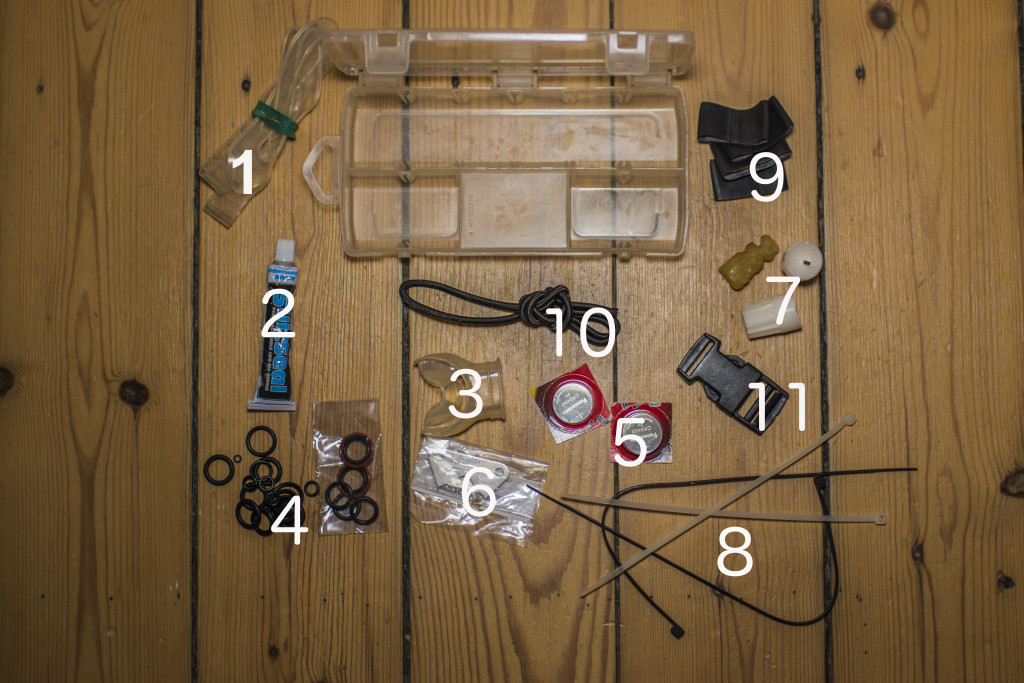For many divers who have just started diving in their own gear, the idea of things breaking may seem far-fetched. But once you’ve had to cancel — or at least opt out of — a dive or an entire dive day because your mask strap snaps, you begin to appreciate the idea that keeping a Save-a-Dive kit can make a huge difference.
As long as you’re on dive trips arranged by dive shops, and renting their gear, spare parts aren’t much of a concern. Most dive shops will have plenty of spares on hand to help you if stuff breaks. But once you start diving independently, with your own gear, you need to be your own backup. And even if you never need anything in your kit, you may be able to save a buddy’s dive. Trust me when I say there’s no better way to gain instant friends than by handing them the spare part they need for the dive they’ve been yearning to do all year.
The exact contents of a Save-a-Dive kit aren’t universal, as what you carry should reflect the gear you carry and the diving you do. Nonetheless, some things will be in most, if not all, kits. Below, I’ll walk you through my own kit for to help inspire yours.
Save-a-Dive Kit
- Mask strap
Mask straps are made of a fairly thin strip of rubber, and as it deteriorates, the chance that it could break is very real. Ideally you should have an extra mask in your kit and bring it on your dive in case the strap breaks mid-dive or you lose your mask. I use a neoprene strap on my masks, which is much less likely to break, but still carry a replacement strap, just in case.
- Sealant for wetsuit and drysuits
With a bit of extra neoprene you can make rudimentary repairs using a sealant. And if your drysuit cuff comes loose, this can seal it up again.
- Spare mouthpiece for regulator
Over time, these will wear down. You may suddenly you find yourself chewing through yours; so keeping a spare is smart.
- An assortment of O-rings
Tons of stuff uses O-rings, and while carrying the standard size is most important, if you’re trained to change the other O-rings on your gear, carry spares of these, too.
- Spare battery for your dive computer
Even with a modern computer’s low-battery warning, an extra battery or two can still make or break a dive day. Carry a spare of whatever battery or batteries your computer takes.
- Tool to change the battery, if needed
- Beeswax and/or candle stubs
Both of these are good for keeping zippers on wetsuits or drysuits running smoothly, or to unstick them if they get stuck.
- Zip ties
These are universally useful, but in particular for attaching your mouthpiece (see above) to your reg if you need to replace it.
- Pieces of bicycle inner tubing
I use these to secure the things I clip to my D-rings, but sometimes, they too break. Replacing them on my rig (I carry a wing and back-plate setup) is a bit cumbersome, but it means I don’t need to do several dives with my spare torch dangling from a D-ring.
- Bungee cord
I use this to attach things to my rig and sometimes my person, such as securing my compass to my arm.
- Spare clip
I don’t have these clips on much of my gear, but still carry one just in case.
- Fin straps
Fin straps suffer the same risk of breaking as a mask strap, so carrying a set of replacements is very useful. (Note: I use spring straps on my fins, so there aren’t any in my kit).
This kit represents half of my backup-equipment plan; I also carry a small diver’s tool kit with basic wrenches, Allen keys, etc. Combined, these two kits have saved many a dive, both mine and my new best friends.’


